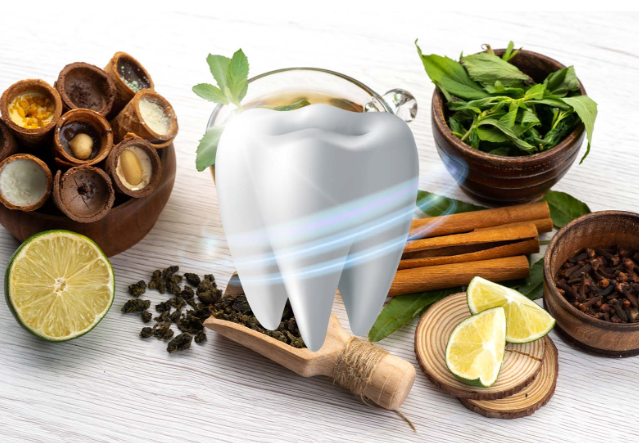The dull, throbbing ache or jarring, sharp pain of a toothache is almost impossible to mistake for anything else. It can spread into your jaw, ears, and sinuses, and the longer you ignore it, the worse it gets.
When you have a problem tooth, it can prevent you from being productive or enjoying your day. Symptoms of a toothache may mean something serious is going on in your tooth or gums, and you should make an appointment with your dentist as soon as possible.
But if you can’t get in right away, what can you do to alleviate the discomfort? Here are four home and natural remedies to help you reduce the pain of a toothache and get back to your day.
1. Try a Rinse
If the pain is just starting a saltwater or hydrogen peroxide rinse can be helpful. These rinses are just strong enough to get rid of any food particles or other debris lodged in the tooth that is causing the irritation.
Salt and hydrogen peroxide are disinfectants, so they do a double duty of healing any open wounds and reducing irritation that inflames the nerves. These three effects may provide almost instant natural relief.
To see if they work for you, mix ½ teaspoon of salt with warm water. Swish in your mouth like you would mouthwash and spit it out. For the peroxide rinse, take equal parts 3% hydrogen peroxide and water and mix them together. Use the solution as a mouthwash, swish, and spit. You should notice the effects of both salt and hydrogen peroxide rinses within a few minutes.
2. Apply Cold Packs
Toothaches often stem from an irritated nerve, and everything, even air, can cause the pain to worsen. When that happens, numbing the nerve with an ice pack may be your next step.
Cold packs are frequently used by doctors as a home remedy for all kinds of pain. The cold temperature, applied to the tissues around the discomfort, constricts the blood vessels and reduces the blood flow. The result is a numbing effect that minimizes the pain. But it can be more than palliative; the cold reduces swelling and inflammation, which may give you long-term relief.
A word of caution: Never use ice directly on the skin. Use a cloth or towel as a layer between the bag of ice or cold pack and direct contact. Keep the ice on the affected area for 15-20 minutes, and repeat every 3-4 hours as needed.
3. Wear a Night Guard
What’s causing your tooth pain plays a massive role in the solution. If your discomfort feels general rather than confined to one specific tooth, the culprit could be bruxism. Better known as teeth grinding, bruxism comes with symptoms like morning headaches, fatigue, bleeding gums, and sensitive teeth.
Teeth grinding happens when your jaws clench unconsciously, usually in your sleep. Because they do this for hours at a time, the grinding and clenching can cause significant problems, like sore muscles and tooth abfractions. This article by JS Dental Lab explains the damage an abfraction can do to your mouth.
The good news is that wearing a night guard while you sleep is a quick and easy way to prevent your grinding from causing further damage to your oral health. Night guards are worn over the upper or lower arch, preventing the teeth from making the contact needed to grind. Consistently wearing this oral appliance also gives your muscles and teeth a much-needed break from bruxing, reducing your pain symptoms.
4. Get Familiar With Natural Remedies
Everything you need to get rid of your toothache pain could be sitting in your kitchen right now. Natural remedies have been used by humans for thousands of years, and they still work today.
What’s in your cupboard? Check for these effective home solutions to get your tooth discomfort under control:
- Garlic- More than a vampire deterrent, garlic has antibacterial properties that kill plaque and can relieve pain. Take a clove of garlic and mash it into a paste with a dab of water and a hint of salt. Apply the paste to the affected tooth. (Note: If you enjoy eating garlic, skip the paste and chew on the clove.)
- Vanilla Extract – The sweetener that gives us chocolate chip cookies is made with alcohol that can help numb pain when applied directly to the problem area with a cotton ball or your finger. For best results, check your bottle and make sure it’s real, not imitation extract.
- Peppermint Tea – Tea bags are a wealth of natural healing, especially peppermint. Apply a warm (not hot), used peppermint tea bag to the sensitive area, and let it sit for 5-10 minutes.
- Clove Oil – Less common in the kitchen, but available in many health food stores, clove oil is historically the go-to toothache reliever. This oil has properties like eugenol, which acts as an antiseptic. Clove oil should be diluted with a carrier oil before application. You can mix a few drops of clove oil with half an ounce of an oil such as sunflower, then apply it to the affected area using a cotton ball.
- Thyme Essential Oil – Thyme is often used to fight bacteria and reduce tooth decay, but its antioxidant and antibacterial properties can also treat the pain of toothaches. Dilute the oil with a carrier oil and apply it to the sensitive area.
These simple yet effective homeopathic plants can work wonders to reduce pain while you’re waiting to see the dentist to find out how to fix the reason for your toothache for good!
Conclusion
When dealing with a toothache, it’s hard to concentrate on anything else! These home and natural remedies can give you the relief you need to reduce the discomfort and get back to your day without pain medication.





